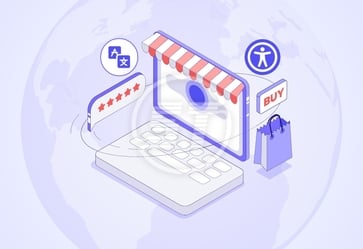‘Tis the holiday and shopping season for all.
Holidays increase sales of stores and with enhanced online shopping trends, it has become one of the most lucrative times of the year for the ecommerce industry. These online stores attract a pool of customers with proper planning and marketing campaigns. However, many ecommerce stores overlook web accessibility and thus several users with disabilities cannot access such stores. So, this festive season when you plan about offers and discounts, focus on store (website) accessibility as well.
Each customer matters to an ecommerce store and due to inaccessibility, stores miss a huge number of potential customers and thus sales. So, let these holidays be yielding for your ecommerce and ecstatic for every user that wishes to shop to celebrate festivals.
Want to know, what can be done to prepare your ecommerce website for the holidays? Read along to know!
Why does an ecommerce website need to be accessible?
Numbers that can’t be ignored!
An ecommerce website that aims for accessibility, opens its doors for every single user and ultimately improves its sales and profits. Research indicates that in the US only around 22 billion dollars business is expected from disabled users. Well, a colossal number to focus on, isn’t it?
User experience matters!
Ecommerce user experience is one facet that impacts overall business in terms of sales and revenue.
Have you ever thought of considering the pain points of users? If not, then now you should. Because it may be one crucial reason behind fewer interactions and conversions during the holiday season.
Login issues, inappropriate navigation path, unsupportive customer care, pathetic speed of the website, incorrect product information, issues in the checkout process, etc. are some important aspects that badly hurt your ecommerce performance.
Accessible websites with readable text, clickable buttons, logical navigation, and proper color contrast have a pleasant and frictionless shopping experience.
Everybody wishes to celebrate!
Though every sort of disability is a hurdle for individuals suffering from them, but some types of impairments impact more than others when it comes to website navigation, for example, blindness, ADHD, autism, etc.
Blinds or users with low vision cannot directly access the websites however they can take screen readers help to access and shop from an ecommerce website. Similarly, people with autism and ADHD might face troubles while going through your ecommerce website. Unreadable product descriptions, too many product videos, or weird navigation paths can become a hurdle and deprive them from shopping.
Added advantage for SEO (Search Engine Optimization)!
Search engines rank websites on factors like user experience, website performance, etc. And when the focus on the ecommerce store’s accessibility, ultimately uplift its SEO.
YOU MAY ALSO LIKE: Ecommerce UX Best Practices
How to make your ecommerce website accessible?
Provide explanatory link text
Instead of writing ‘click here’, provide some meaningful link text to improve its clarity. So that users will understand the result of clicking on the link. For example, ‘Read more about products’ or ‘Click for zoom out view’. It will help users to decide where to click and where not to.
Text readability
There should be text readability to make the whole website content legible for everyone. WCAG has specified in its success criteria 3.1 about sentence length, word abbreviation, page language, and so on. Also, ensure there is appropriate contrast between text and background color (success criteria 1.4.3).
Keyboard navigation
Users with mobility impairments cannot use the mouse to navigate and shop through ecommerce website. Therefore, providing a keyboard-friendly design is a mandatory requirement for ecommerce websites.
44x44 px. clickable area for touch control
Call-to-action (CTA) buttons are important for ecommerce websites such as ‘Buy now’ or ‘Add to cart’. If they are not visible or clickable, you might lose customers. Thus, provide a proper size of 44x44 px. for these buttons. So that users can find and click on them to complete their transactions.
Video content with captions
If there are videos in the product’s description, make sure it has captions for better understanding. Captions help users with screen readers to know correct details about the products.
Learn from real users' feedback
Despite testing ecommerce website for all permutations and combinations, users with disabilities might encounter trouble. For example, color-blind people may not see the CTAs or screen readers cannot navigate through the checkout page properly. Thus, take feedback from people with disabilities and fix the issues ASAP.
Website access through a broader range of devices
Ecommerce websites must be accessible properly via a variety of web browsers and other devices for all users. It ultimately improves your ecommerce website’s accessibility and engages more customers.
Smoother checkout process
The most crucial part of an ecommerce website is its checkout process. All the form fields must have a clear message to rectify errors (WCAG success criteria 1.3, 3.2, and 3.3). There must be multiple and secured payment options. Lesser details to be filled to make checkout simple and swift. Painless checkout also avoids abandoned cart rates and increases conversions.
Provide accessibility guide
To help all assistive technology users navigate through the website, you can create an accessibility guide. A guide with information on how they can navigate and purchase from your ecommerce using assistive technology. It will also include the alternative solution for the elements that are not accessible (in case there are any). Contact information can also be added for users’ convenience.
Alt text for images, consistent design, and regular testing are some other important points that cannot be overlooked.
YOU MAY ALSO LIKE: Customer Engagement Strategies Ecommerce
Have you come across any real-world example of accessible and successful ecommerce website?
Many ecommerce giants have recognized the benefits and importance of web accessibility and thus included it in their systems. Web accessibility resulted in an omnichannel presence for them. Some of the renowned examples are:
- Amazon - it has imbibed digital accessibility into its core and the result is its immense popularity across the world. Users can easily navigate through Amazon website using screen readers and other assistive technologies and find their desired products.
- Walmart – its website has an accessibility page to provide information about the company’s commitment to digital accessibility. Keyboard navigation, accessible forms, and screen reader compatibility are available on Walmart's ecommerce website.
- Target – it is also a fabulous example of digital accessibility. They have included accessibility guidelines in their design and development process.
Isn’t ecommerce accessibility a win-win for everyone?
If ecommerce accessibility improves the shopping experience for many users, on the other hand, it also increases online stores’ sales. Thus, accessibility inclusion is beneficial for shops and shoppers both. As the holiday season is around the corner, begin reviewing your websites and fixing their accessibility issues. Plan for accessibility along with other marketing campaigns!
As an associate member of International Association of Accessibility Professionals (IAAP), Skynet Technologies is a part of Global accessibility community. Our commitment to the IAAP guarantee people all over the world to understand and implement accessibility strategies.
As an official member of the W3C, Skynet Technologies provide comprehensive ADA website accessibility services which includes ADA website audit, strategy, design, development, remediation, and support with accessibility regulations such as ADA, WCAG 2.0, 2.1, 2.2, and Section 508 within your budget. Request a free ADA web accessibility quote or reach out hello@skynettechnologies.com.


